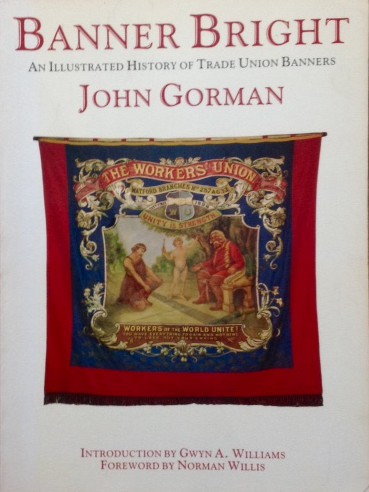Inspiring Older Readers
 posted on 21 Aug 2016
posted on 21 Aug 2016
Banner Bright : an illustrated history of trade union banners by John Gorman
Has the British labour movement produced anything more wonderful than the trade union or campaign banner? I can clearly remember when I was a young teenager looking at black and white photographs or paintings of union marches or mass rallies and being fascinated by the huge banners, carried on poles by two men, that rippled and waved over the heads of the protesters - more substantial than a mere flag and telling the world some kind of story in simple pictures. But, when I actually saw some of these banners in real life I was completely blown away by the sheer brilliance of the art and the skill of the craft involved in their production.

I was recently reminded of just how breathtaking the radical banner can be when I visited the People's Palace museum in Glasgow. On the top floor of the building there is a large room dedicated to the crucial role the people of Glasgow played in the development of trade unionism, British communism and popular protest and much of the impact comes from the astonishing banners they have collected.
John Gorman's history of the trade union banner is a really excellent introduction this fantastic working class art-form. Although it was published in 1986 and so does not include some remarkable examples from the very late twentieth and early twenty-first centuries, the historical overview is essential. I was astonished to discover that the tradition of banner making came to a crashing halt in 1951, following the electoral defeat of the Labour Party and the consequent thirteen years of Tory misrule. Many superb banners were lost in these years, lying rotting in basements and storerooms. Thankfully, the TUC in the early Seventies revived the use of banners to mark their anti-union campaigns and not only brought back the old examples but began to redesign and reimagine what the banner should look like and what they were commemorating.
Gorman's book is a fascinating journey through some of the original thinking behind the banners and how traditional styles emerged - telling us as well just how they were manufactured. There are separate chapters looking at banners to mark trade union branches, specific campaigns, working class heroes and even the men and women who carry the banners.


My only real criticism of the book is that way too many of the illustrations are black and white when colour would have given many of the banners a proper showcase. I guess this is a budget issue because there are a number of colour plates inter- leaved with the monochrome ones and there are enough of those to give the reader a positive feel for the impact these banners can make.
If I was asked to name the thing I would most like to own that would represent my forty years working for and being a trade union member, it would most certainly be one of these wonderful banners.
Terry Potter
August 2016



